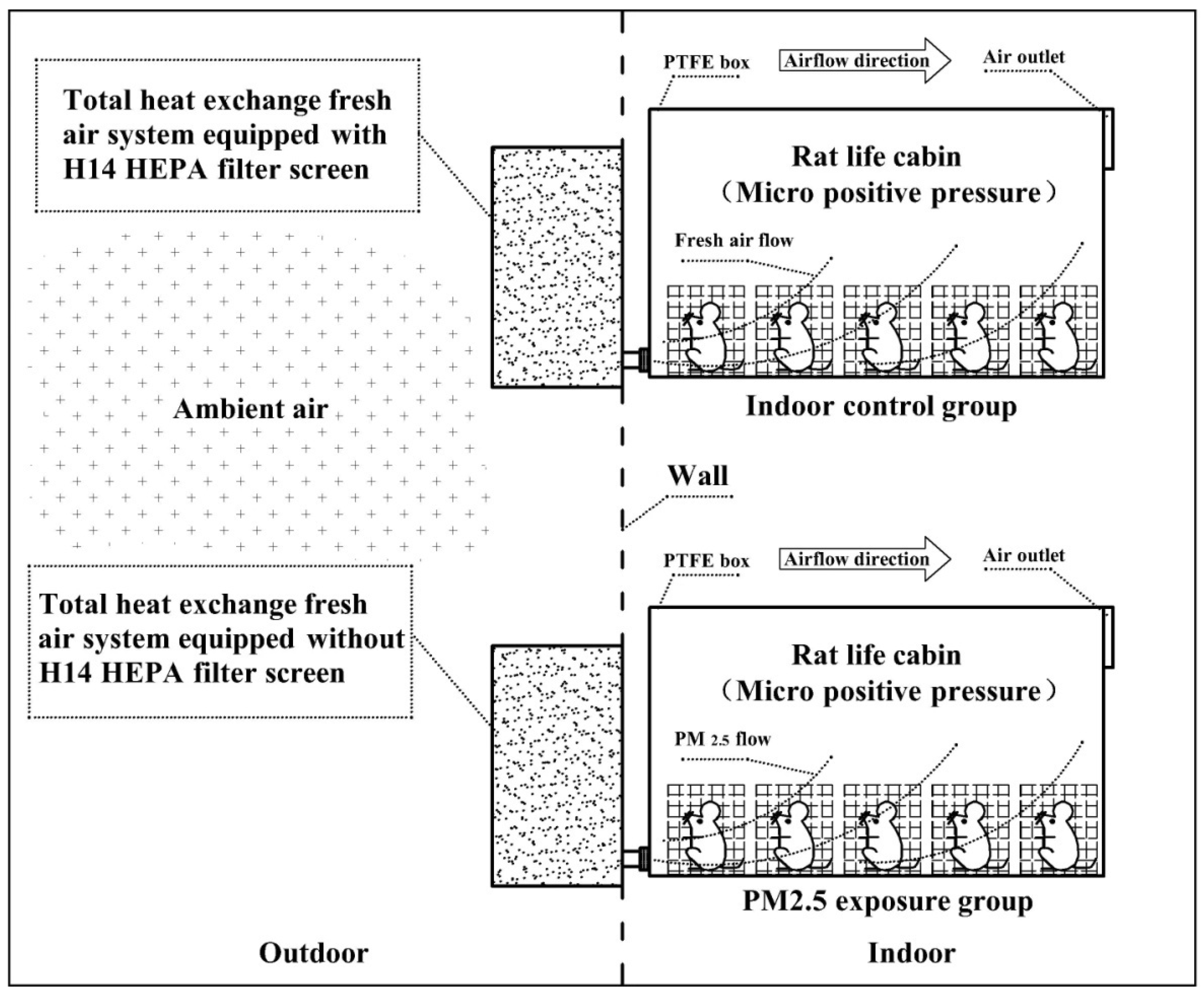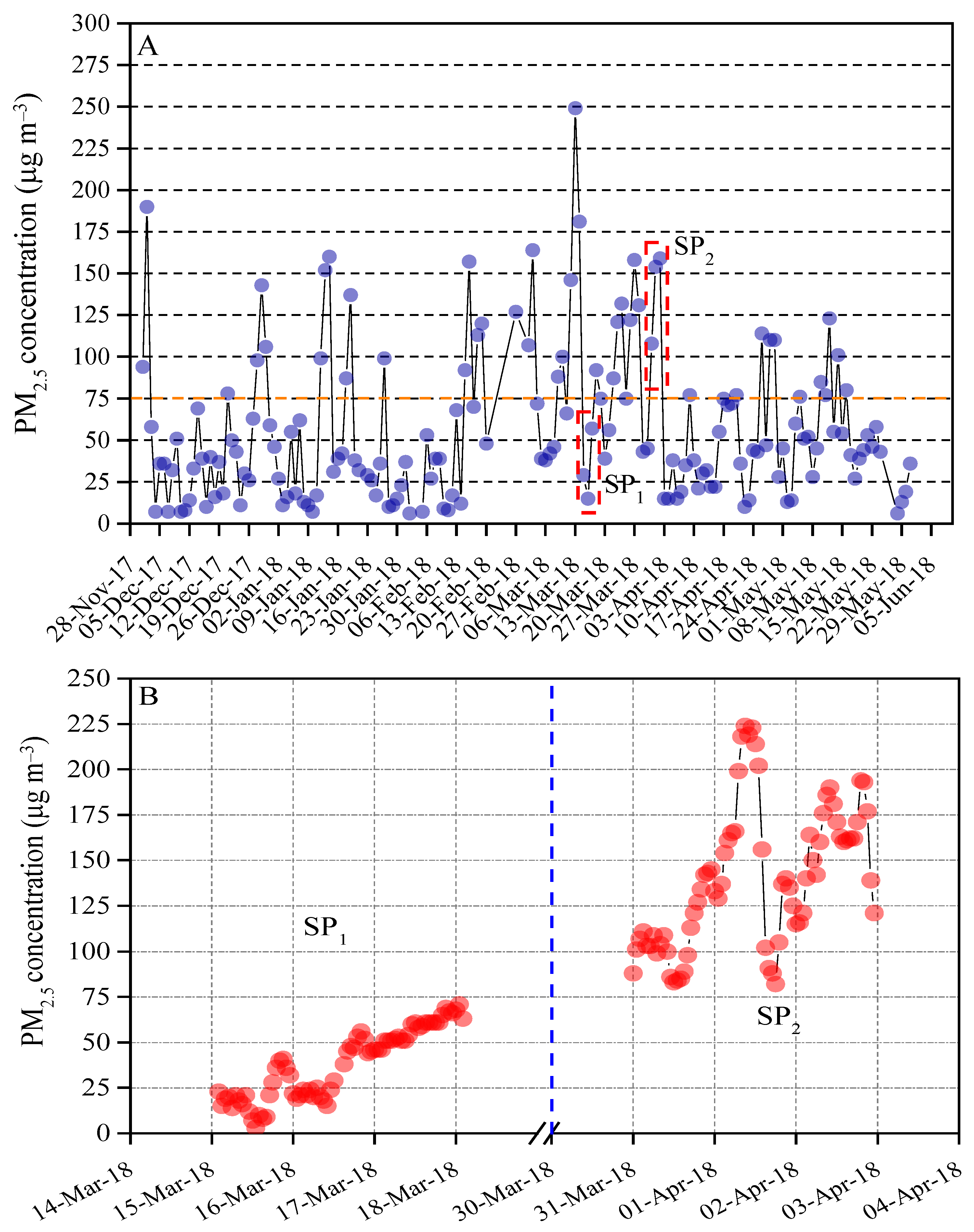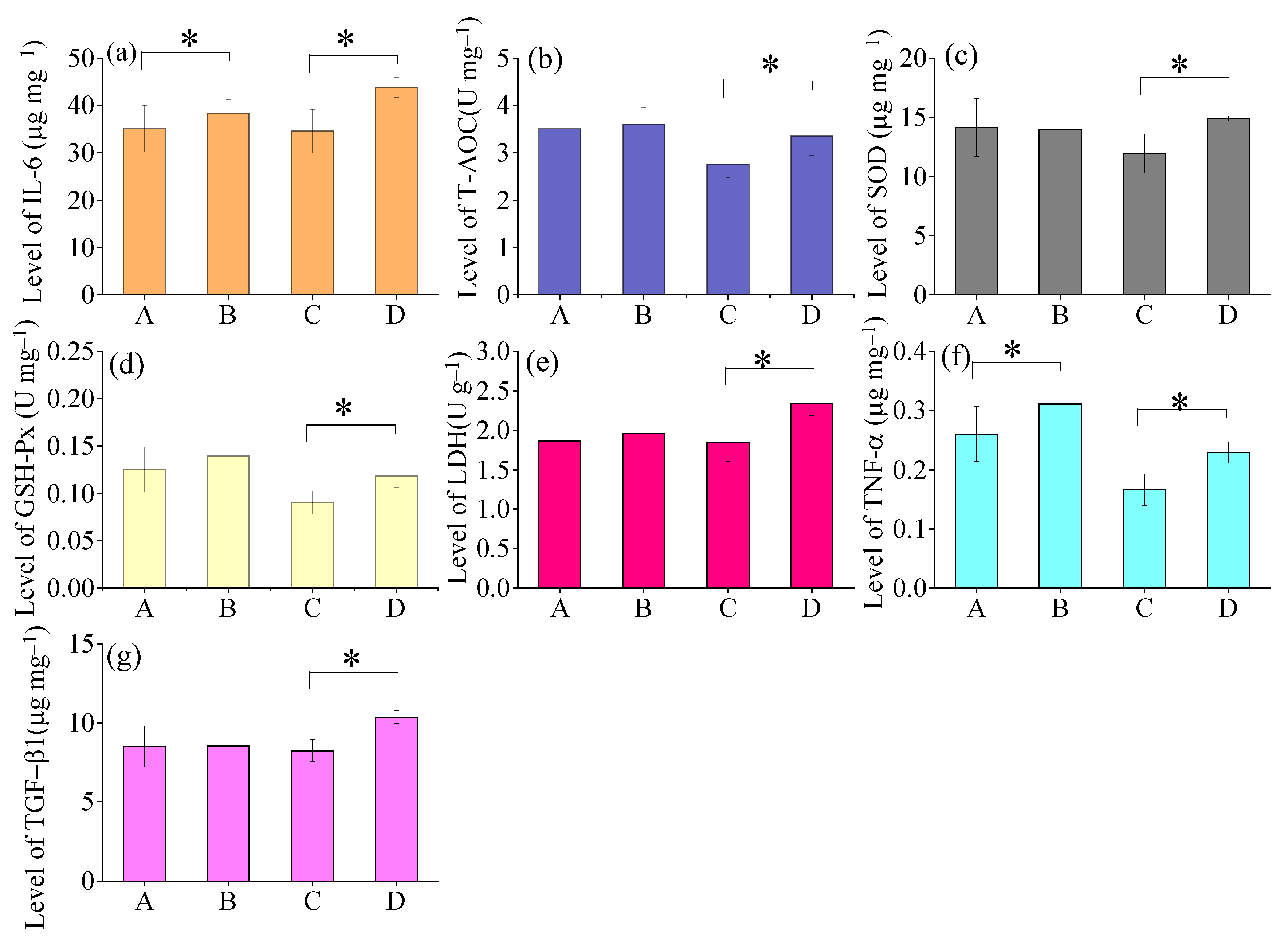The Effects of Indoor Air Filter on Reductions in PM2.5 Associated Health Risks of Respiratory Function in Mouse
Abstract
:1. Introduction
2. Experimental
2.1. Exposure System of Ambient PM2.5 for Mouse
2.2. Sampling Site
2.3. Bodyweight
2.4. Respiratory Function Parameters
2.5. Measurement of Cytokine in Lung Tissue
2.6. Statistical Analysis
3. Results
3.1. Indoor and Outdoor PM2.5 Mass
3.2. Changes in Body Weights
3.3. Respiratory Function
3.4. Inflammatory Responses
4. Discussion
5. Conclusions
Supplementary Materials
Author Contributions
Funding
Institutional Review Board Statement
Informed Consent Statement
Data Availability Statement
Acknowledgments
Conflicts of Interest
References
- Global Burden of Disease Cancer Collaboration. Global, regional, and national disability-adjusted life-years (DALYs) for 333 diseases and injuries and healthy life expectancy (HALE) for 195 countries and territories, 1990–2016: A systematic analysis for the Global Burden of Disease Study 2016. Lancet 2017, 390, 1260–1344. [Google Scholar] [CrossRef] [Green Version]
- Bell, M.L. Assessment of the health impacts of particulate matter characteristics. Res. Rep. Health Eff. Inst. 2012, 161, 5–38. [Google Scholar]
- Becher, R.; Bucht, A.; Øvrevik, J.; Hongslo, J.K.; Dahlman, H.J.; Samuelsen, J.T.; Schwarze, P.E. Involvement of NADPH oxidase and iNOS in rodent pulmonary cytokine responses to urban sir and mineral particles. Inhal. Toxicol. 2007, 19, 645–655. [Google Scholar] [CrossRef] [PubMed]
- Brook, R.D.; Rajagopalan, S.; Pope, C.A.; Brook, J.R.; Bhatnagar, A.; Diez-Roux, A.V.; Holguin, F.; Hong, Y.; Luepker, R.V.; Mittleman, M.A.; et al. Particulate Matter Air Pollution and Cardiovascular Disease. Circulation 2010, 121, 2331–2378. [Google Scholar] [CrossRef] [Green Version]
- Liu, Q.; Baumgartner, J.; Schauer, J.J. Source apportionment of fine-particle, water-soluble organic nitrogen and its association with the inflammatory potential of lung epithelial cells. Environ. Sci. Technol. 2019, 53, 9845–9854. [Google Scholar] [CrossRef]
- Liu, Q.; Baumgartner, J.; Zhang, Y.; Schauer, J.J. Source apportionment of Beijing air pollution during a severe winter haze event and associated pro-inflammatory responses in lung epithelial cells. Atmos. Environ. 2016, 126, 28–35. [Google Scholar] [CrossRef]
- Li, N.; Wang, M.; Bramble, L.A.; Schmitz, D.A.; Schauer, J.J.; Sioutas, C.; Harkema, J.R.; Nel, A.E. The adjuvant effect of ambient particulate matter is closely reflected by the particulate oxidant potential. Environ. Health Perspect. 2009, 117, 1116–1123. [Google Scholar] [CrossRef]
- Yang, Z.; Liu, Q.; Liu, Y.; Qi, X.; Wang, X. Cell cycle arrest of human bronchial epithelial cells modulated by differences in chemical components of particulate matter. RSC Adv. 2021, 11, 10582–10591. [Google Scholar] [CrossRef]
- Liu, Q.; Baumgartner, J.; Zhang, Y.; Liu, Y.; Sun, Y.; Zhang, M. Oxidative potential and inflammatory impacts of source apportioned ambient air pollution in Beijing. Environ. Sci. Technol. 2014, 48, 12920–12929. [Google Scholar] [CrossRef]
- Liu, C.; Cai, J.; Qiao, L.; Wang, H.; Xu, W.; Li, H.; Zhao, Z.; Chen, R.; Kan, H. The acute effects of fine particulate matter constituents on blood inflammation and coagulation. Environ. Sci. Technol. 2017, 51, 8128–8137. [Google Scholar] [CrossRef]
- Liu, Q.; Baumgartner, J.; de Foy, B.; Schauer, J.J. A global perspective on national climate mitigation priorities in the context of air pollution and sustainable development. City Environ. Interact. 2019, 1, 100003. [Google Scholar] [CrossRef]
- Lai, A.M.; Clark, S.; Carter, E.; Shan, M.; Ni, K.; Yang, X.; Baumgartner, J.; Schauer, J.J. Impacts of stove/fuel use and outdoor air pollution on chemical composition of household particulate matter. Indoor Air 2020, 30, 294–305. [Google Scholar] [CrossRef]
- Chen, S.; Jiang, N.; Huang, J.; Zang, Z.; Guan, X.; Ma, X.; Luo, Y.; Li, J.; Zhang, X.; Zhang, Y. Estimations of indirect and direct anthropogenic dust emission at the global scale. Atmos. Environ. 2019, 200, 50–60. [Google Scholar] [CrossRef]
- Zhu, C.; Tian, H.; Hao, J. Global anthropogenic atmospheric emission inventory of twelve typical hazardous trace elements, 1995–2012. Atmos. Environ. 2020, 220, 117061. [Google Scholar] [CrossRef]
- Barkjohn, K.K.; Norris, C.; Cui, X.; Fang, L.; Zheng, T.; Schauer, J.J.; Li, Z.; Zhang, Y.; Black, M.; Zhang, J.; et al. Real-time measurements of PM2.5 and ozone to assess the effectiveness of residential indoor air filtration in Shanghai homes. Indoor Air 2021, 31, 74–87. [Google Scholar] [CrossRef]
- He, L.; Li, Z.; Teng, Y.; Cui, X.; Barkjohn, K.K.; Norris, C.; Fang, L.; Lin, L.; Wang, Q.; Zhou, X.; et al. Associations of personal exposure to air pollutants with airway mechanics in children with asthma. Environ. Int. 2020, 138, 105647. [Google Scholar] [CrossRef]
- Waring, M.S.; Siegel, J.A.; Corsi, R.L. Ultrafine particle removal and generation by portable air cleaners. Atmos. Environ. 2008, 42, 5003–5014. [Google Scholar] [CrossRef]
- Isiugo, K.; Jandarov, R.; Cox, J.; Chillrud, S.; Grinshpun, S.A.; Hyttinen, M.; Yermakov, M.; Wang, J.; Ross, J.; Reponen, T. Predicting indoor concentrations of black carbon in residential environments. Atmos. Environ. 2019, 201, 223–230. [Google Scholar] [CrossRef]
- Lamichhane, D.K.; Jung, D.-Y.; Shin, Y.-J.; Lee, K.-S.; Lee, S.-Y.; Ahn, K.; Kim, K.W.; Shin, Y.H.; Suh, D.I.; Hong, S.-J.; et al. Association of ambient air pollution with depressive and anxiety symptoms in pregnant women: A prospective cohort study. Int. J. Hyg. Environ. Health 2021, 237, 113823. [Google Scholar] [CrossRef]
- Bauerová, P.; Šindeláˇrová, A.; Rychlík, Š.; Novák, Z.; Keder, J. Low-cost air quality sensors: One-year field comparative measurement of different gas sensors and particle counters with reference monitors at tusimice observatory. Atmosphere 2020, 11, 492. [Google Scholar] [CrossRef]
- Liu, W.; Yang, Z.; Liu, Q. Estimations of ambient fine particle and ozone level at a suburban site of Beijing in winter. Environ. Res. Commun. 2021, 3, 081008. [Google Scholar] [CrossRef]
- Liu, Y.; Yang, Z.; Liu, Q.; Qi, X.; Qu, J.; Zhang, S.; Wang, X.; Jia, K.; Zhu, M. Study on chemical components and sources of PM2.5 during heavy air pollution periods at a suburban site in Beijing of China. Atmos. Pollut. Res. 2021, 12, 188–199. [Google Scholar] [CrossRef]
- Li, L.; Zhou, L.; Feng, T.; Hao, G.; Yang, S.; Wang, N.; Yan, L.; Pang, Y.; Niu, Y.; Zhang, R. Ambient air pollution exposed during preantral-antral follicle transition stage was sensitive to associate with clinical pregnancy for women receiving IVF. Environ. Pollut. 2020, 265, 114973. [Google Scholar] [CrossRef] [PubMed]
- Nirogi, R.; Shanmuganathan, D.; Jayarajan, P.; Abraham, R.; Kancharla, B. Comparison of whole body and head out plethysmography using respiratory stimulant and depressant in conscious rats. J. Pharmacol. Tox. Met. 2012, 65, 37–43. [Google Scholar] [CrossRef]
- Fares, R.; Bory, C.; Valgalier, C.; Baudet, S. Implementation of DSI FinePointe® whole body plethysmography method in freely moving rats. J. Pharmacol. Tox. Met. 2019, 99, 106595. [Google Scholar] [CrossRef]
- Huang, S.; Zhang, X.; Huang, J.; Lu, X.; Liu, F.; Gu, D. Ambient air pollution and body weight status in adults: A systematic review and meta-analysis. Environ. Pollut. 2020, 265, 114999. [Google Scholar] [CrossRef]
- Zhang, Z.; Dong, B.; Chen, G.; Song, Y.; Li, S.; Yang, Z.; Dong, Y.; Wang, Z.; Ma, J.; Guo, Y. Ambient air pollution and obesity in school-aged children and adolescents: A multicenter study in China. Sci. Total Environ. 2021, 771, 144583. [Google Scholar] [CrossRef]
- Mousavi, E.S.; Godri Pollitt, K.J.; Sherman, J.; Martinello, R.A. Performance analysis of portable HEPA filters and temporary plastic anterooms on the spread of surrogate coronavirus. Build. Environ. 2020, 183, 107186. [Google Scholar] [CrossRef]
- Wang, Y.-C.; Lu, M.-C.; Yang, S.-F.; Bien, M.-Y.; Chen, Y.-F.; Li, Y.-T. Respiratory care for the critical patients with 2019 novel coronavirus. Respir. Med. 2021, 186, 106516. [Google Scholar] [CrossRef]
- Wenke, C.; Pospiech, J.; Reutter, T.; Truyen, U.; Speck, S. Efficiency of different air filter types for pig facilities at laboratory scale. PLoS ONE 2017, 12, e0186558. [Google Scholar] [CrossRef] [Green Version]
- Chen, X.Y.; Chen, Y.Y.; Lin, W.; Chien, C.W.; Chen, C.H.; Wen, Y.C.; Hsiao, T.C.; Chuang, H.C. Effects of human umbilical cord-derived mesenchymal stem cells on the acute cigarette smoke-induced pulmonary inflammation model. Front. Physiol. 2020, 11, 962. [Google Scholar] [CrossRef]
- Haghani, A.; Johnson, R.; Safi, N.; Zhang, H.; Thorwald, M.; Mousavi, A.; Woodward, N.C.; Shirmohammadi, F.; Coussa, V.; Wise, J.P.; et al. Toxicity of urban air pollution particulate matter in developing and adult mouse brain: Comparison of total and filter-eluted nanoparticles. Environ. Int. 2020, 136, 105510. [Google Scholar] [CrossRef]
- Tamana, S.K.; Gombojav, E.; Kanlic, A.; Banzrai, C.; Batsukh, S.; Enkhtuya, E.; Boldbaatar, B.; Lanphear, B.P.; Lear, S.A.; McCandless, L.C.; et al. Portable HEPA filter air cleaner use during pregnancy and children’s body mass index at two years of age: The UGAAR randomized controlled trial. Environ. Int. 2021, 56, 106728. [Google Scholar] [CrossRef]
- Gaskins, A.J.; Tang, Z.; Hood, R.B.; Ford, J.; Schwartz, J.D.; Jones, D.P.; Laden, F.; Liang, D. Periconception air pollution, metabolomic biomarkers, and fertility among women undergoing assisted reproduction. Environ. Int. 2021, 155, 106666. [Google Scholar] [CrossRef]



| Indicator | Male Group A (n = 5) | Male Group B (n = 5) | p-Value | Female Group A (n = 5) | Female Group B (n = 5) | p-Value |
|---|---|---|---|---|---|---|
| Respiratory rate (BPM) | 525.8 ± 21.6 | 527.8 ± 29.9 | 0.07 | 502.7 ± 19.3 | 545.2 ± 23.6 | 0.01 |
| Tidal inhaled volume (mL) | 0.2 ± 0.02 | 0.2 ± 0.02 | 0.09 | 0.2 ± 0.03 | 0.2 ± 0.02 | 0.09 |
| Minute volume (mL min−1) | 83.5 ± 9.1 | 100.4 ± 15.8 | 0.02 | 91.3 ± 8.5 | 98.2 ± 6.1 | 0.02 |
| Index of constriction | 0.4 ± 0.07 | 0.3 ± 0.06 | 0.13 | 0.3 ± 0.04 | 0.4 ± 0.07 | 0.09 |
| Expiratory pause time (s) | 0.5 ± 0.08 | 0.5 ± 0.06 | 0.11 | 0.5 ± 0.03 | 0.5 ± 0.07 | 0.011 |
| Peak expiratory time | 0.7 ± 0.04 | 0.7 ± 0.03 | 0.09 | 0.7 ± 0.03 | 0.7 ± 0.06 | 0.12 |
| Estimated peak inspiratory flow (mL s−1) | 5.7 ± 0.5 | 6.7 ± 0.9 | 0.07 | 6.2 ± 0.4 | 6.4 ± 0.2 | 0.12 |
| Estimated peak expiratory flow (mL s−1) | 3.9 ± 0.7 | 4.3 ± 0.8 | 0.06 | 4.0 ± 0.6 | 4.5 ± 0.3 | 0.13 |
| Inspiratory time (s) | 0.05 ± 0.003 | 0.05 ± 0.003 | 0.08 | 0.05 ± 0.005 | 0.05 ± 0.001 | 0.14 |
| Expiratory time (s) | 0.07 ± 0.008 | 0.08 ± 0.008 | 0.09 | 0.09 ± 0.009 | 0.07 ± 0.005 | 0.03 |
| Expiratory flow at 50% expired volume (mL s−1) | 0.3 ± 0.05 | 0.3 ± 0.07 | 0.10 | 0.3 ± 0.04 | 0.3 ± 0.03 | 0.14 |
| Relaxation time (s) | 0.05 ± 0.004 | 0.05 ± 0.007 | 0.12 | 0.06 ± 0.007 | 0.04 ± 0.005 | 0.02 |
| Duration of breaking (%) | 17.5 ± 1.2 | 17.2 ± 0.9 | 0.11 | 15.8 ± 1.3 | 18.3 ± 0.7 | 0.02 |
| Duration of pause before inspiration (%) | 10.2 ± 1.0 | 10.6 ± 0.5 | 0.07 | 10.8 ± 1.0 | 10.3 ± 1.2 | 0.15 |
| Rejection index (%) | 78.5 ± 4.3 | 79.7 ± 2.5 | 0.17 | 80.0 ± 8.2 | 76.8 ± 1.1 | 0.09 |
Publisher’s Note: MDPI stays neutral with regard to jurisdictional claims in published maps and institutional affiliations. |
© 2022 by the authors. Licensee MDPI, Basel, Switzerland. This article is an open access article distributed under the terms and conditions of the Creative Commons Attribution (CC BY) license (https://creativecommons.org/licenses/by/4.0/).
Share and Cite
Yang, Z.; Liu, Q.; Liu, Y.; Guo, Q.; Shan, Y.; Cheng, Z.; Zhong, Z. The Effects of Indoor Air Filter on Reductions in PM2.5 Associated Health Risks of Respiratory Function in Mouse. Atmosphere 2022, 13, 1005. https://doi.org/10.3390/atmos13071005
Yang Z, Liu Q, Liu Y, Guo Q, Shan Y, Cheng Z, Zhong Z. The Effects of Indoor Air Filter on Reductions in PM2.5 Associated Health Risks of Respiratory Function in Mouse. Atmosphere. 2022; 13(7):1005. https://doi.org/10.3390/atmos13071005
Chicago/Turabian StyleYang, Zheng, Qingyang Liu, Yanju Liu, Qingyun Guo, Yunfang Shan, Zhibin Cheng, and Zhenyu Zhong. 2022. "The Effects of Indoor Air Filter on Reductions in PM2.5 Associated Health Risks of Respiratory Function in Mouse" Atmosphere 13, no. 7: 1005. https://doi.org/10.3390/atmos13071005
APA StyleYang, Z., Liu, Q., Liu, Y., Guo, Q., Shan, Y., Cheng, Z., & Zhong, Z. (2022). The Effects of Indoor Air Filter on Reductions in PM2.5 Associated Health Risks of Respiratory Function in Mouse. Atmosphere, 13(7), 1005. https://doi.org/10.3390/atmos13071005








